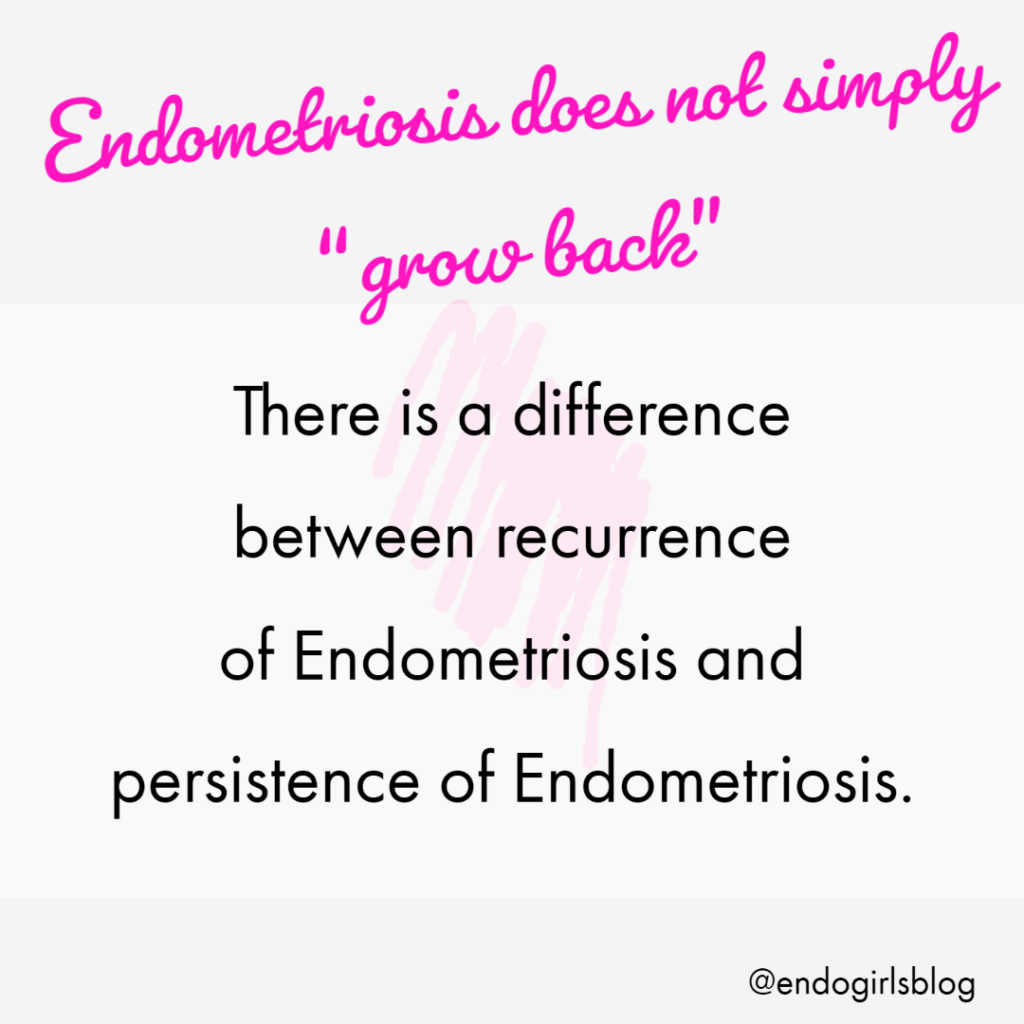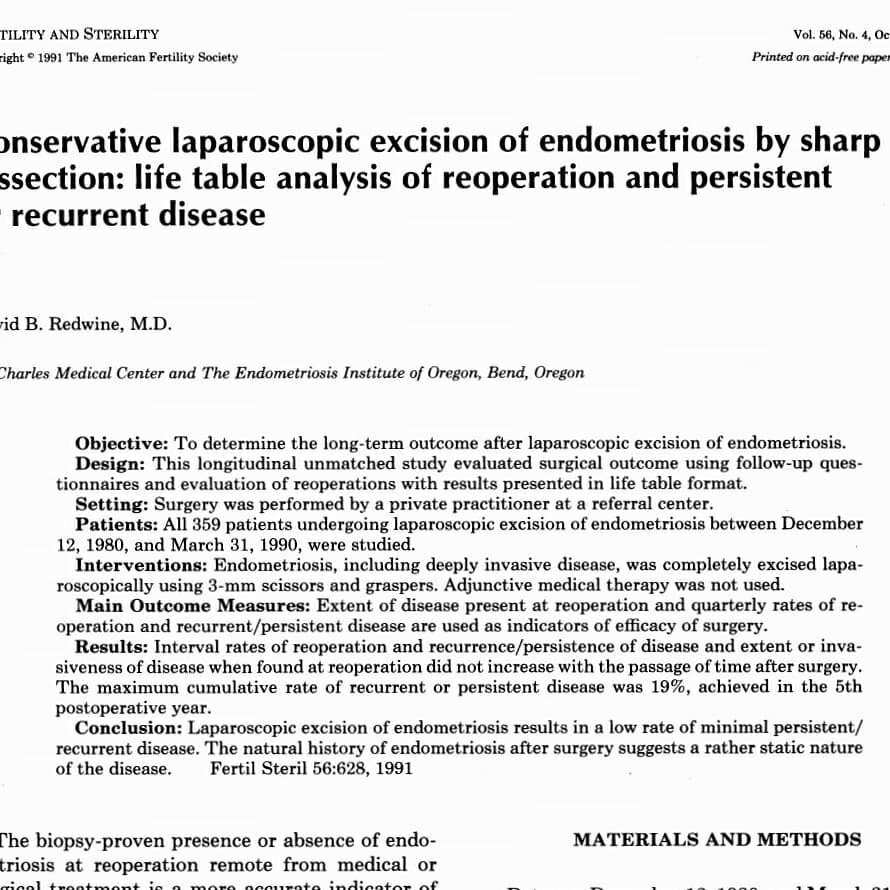Endometriosis Does Not Simply “Grow Back.”

There is a lot to be said about this! Many websites and even OBGYNs will tell their patients that their Endometriosis will inevitably grow back and that they will need repeated surgeries, and this is considered recurrence.
The problem with this is that we know that if Endometriosis is entirely and intricately cut out (excised), it is much less likely to return. More often than not it is persistence (it persists because it was not completely cut out) This happens because it was inadequately treated – either ablated (typically burnt) or not completely excised (tissue around the lesion was left behind, it wasn’t cut out deep enough, etc.) Like a cancerous tumor, every single bit of each area with Endometriosis must be excised. You may have heard about wide excision- this is the practice of removing a wide margin around where Endometriosis is seen. This increases the likelihood that all of the Endometriosis was removed, especially because some Endometriosis is difficult to see. Some of the best surgeons don’t practice this because they don’t want to remove or damage the tissue that may appear to be healthy. I think that is a conversation that should be had between patient and surgeon. I personally wanted as much tissue removed as possible. So, where are the statistics on this, and how do we know recurrence is unlikely in the event of thorough excision? We are somewhat limited because of the nature of that type of study (surgeon skill, multiple surgeries, patients willing to undergo multiple surgeries at different time intervals – you get the idea). But we do have good data – good meaning quality over quantity, and obviously more is needed. Yeung et al. did a five-year follow-up from true complete excision “At surgery, histologic analysis confirmed Endometriosis in 17 of the 20 (85%) patients. …During follow-up of up to 66 months (average, 23.1 months), 8 of 17 (47%) patients underwent a subsequent laparoscopy for persistent recurrent pain. None of these patients had Endometriosis diagnosed visually or histologically. Half of the girls had adhesions.”
WE KNOW PAIN RELIEF IS NOT 100% FOR EVERYONE.
Sources:


1.) 𝘾𝙤𝙣𝙨𝙚𝙧𝙫𝙖𝙩𝙞𝙫𝙚 𝙡𝙖𝙥𝙖𝙧𝙤𝙨𝙘𝙤𝙥𝙞𝙘 𝙚𝙭𝙘𝙞𝙨𝙞𝙤𝙣 𝙤𝙛 𝙚𝙣𝙙𝙤𝙢𝙚𝙩𝙧𝙞𝙤𝙨𝙞𝙨 𝙗𝙮 𝙨𝙝𝙖𝙧𝙥 𝙙𝙞𝙨𝙨𝙚𝙘𝙩𝙞𝙤𝙣: 𝙡𝙞𝙛𝙚 𝙩𝙖𝙗𝙡𝙚 𝙖𝙣𝙖𝙡𝙮𝙨𝙞𝙨 𝙤𝙛 𝙧𝙚𝙤𝙥𝙚𝙧𝙖𝙩𝙞𝙤𝙣 𝙖𝙣𝙙 𝙥𝙚𝙧𝙨𝙞𝙨𝙩𝙚𝙣𝙩 𝙤𝙧 𝙧𝙚𝙘𝙪𝙧𝙧𝙚𝙣𝙩 𝙙𝙞𝙨𝙚𝙖𝙨𝙚. 𝘿𝙖𝙫𝙞𝙙 𝘽. 𝙍𝙚𝙙𝙬𝙞𝙣𝙚, 𝙈.𝘿.
2. 𝙍𝙀𝘾𝙏𝘼𝙇 𝙀𝙉𝘿𝙊𝙈𝙀𝙏𝙍𝙄𝙊𝙎𝙄𝙎: 𝙍𝙀𝙎𝙐𝙇𝙏𝙎 𝙊𝙁 𝙍𝘼𝘿𝙄𝘾𝘼𝙇 𝙀𝙓𝘾𝙄𝙎𝙄𝙊𝙉 𝘼𝙉𝘿 𝙍𝙀𝙑𝙄𝙀𝙒 𝙊𝙁 𝙋𝙐𝘽𝙇𝙄𝙎𝙃𝙀𝘿 𝙒𝙊𝙍𝙆. 𝙍𝙞𝙘𝙝𝙖𝙧𝙙 𝘽𝙧𝙤𝙪𝙬𝙚𝙧 𝙍𝙤𝙙𝙣𝙚𝙮 𝙅. 𝙒𝙤𝙤𝙙𝙨
3. 𝘾𝙤𝙢𝙥𝙡𝙚𝙩𝙚 𝙡𝙖𝙥𝙖𝙧𝙤𝙨𝙘𝙤𝙥𝙞𝙘 𝙚𝙭𝙘𝙞𝙨𝙞𝙤𝙣 𝙤𝙛 𝙚𝙣𝙙𝙤𝙢𝙚𝙩𝙧𝙞𝙤𝙨𝙞𝙨 𝙞𝙣 𝙩𝙚𝙚𝙣𝙖𝙜𝙚𝙧𝙨: 𝙞𝙨 𝙥𝙤𝙨𝙩𝙤𝙥𝙚𝙧𝙖𝙩𝙞𝙫𝙚 𝙝𝙤𝙧𝙢𝙤𝙣𝙖𝙡 𝙨𝙪𝙥𝙥𝙧𝙚𝙨𝙨𝙞𝙤𝙣 𝙣𝙚𝙘𝙚𝙨𝙨𝙖𝙧𝙮? 𝙋𝙧𝙚𝙨𝙚𝙣𝙩𝙚𝙙 𝙖𝙨 𝙖𝙣 𝙤𝙧𝙖𝙡 𝙥𝙧𝙚𝙨𝙚𝙣𝙩𝙖𝙩𝙞𝙤𝙣 𝙖𝙩 𝙩𝙝𝙚 𝘼𝙢𝙚𝙧𝙞𝙘𝙖𝙣 𝘼𝙨𝙨𝙤𝙘𝙞𝙖𝙩𝙞𝙤𝙣 𝙤𝙛 𝙂𝙮𝙣𝙚𝙘𝙤𝙡𝙤𝙜𝙞𝙘 𝙇𝙖𝙥𝙖𝙧𝙤𝙨𝙘𝙤𝙥𝙞𝙨𝙩𝙨 (𝘼𝘼𝙂𝙇) 𝘼𝙣𝙣𝙪𝙖𝙡 𝘾𝙤𝙣𝙛𝙚𝙧𝙚𝙣𝙘𝙚, 𝙇𝙖𝙨 𝙑𝙚𝙜𝙖𝙨, 𝙉𝙚𝙫𝙖𝙙𝙖, 𝙉𝙤𝙫𝙚𝙢𝙗𝙚𝙧 8-12, 2010; 𝙖𝙣𝙙 𝙖 𝙥𝙤𝙨𝙩𝙚𝙧 𝙥𝙧𝙚𝙨𝙚𝙣𝙩𝙖𝙩𝙞𝙤𝙣 𝙖𝙩 𝙩𝙝𝙚 𝙒𝙤𝙧𝙡𝙙 𝙎𝙮𝙢𝙥𝙤𝙨𝙞𝙪𝙢 𝙤𝙛 𝙀𝙣𝙙𝙤𝙢𝙚𝙩𝙧𝙞𝙤𝙨𝙞𝙨 𝘾𝙤𝙣𝙛𝙚𝙧𝙚𝙣𝙘𝙚 𝙈𝙖𝙧𝙘𝙝 24-26, 2011. 𝙋𝙖𝙩𝙧𝙞𝙘𝙠𝙔𝙚𝙪𝙣𝙜𝙅𝙧 .𝙈.𝘿. 𝙆𝙚𝙣𝙎𝙞𝙣𝙚𝙧𝙫𝙤 𝙈.𝘿. 𝙒𝙚𝙣𝙙𝙮𝙒𝙞𝙣𝙚𝙧 𝙍.𝙉. 𝙍𝙤𝙗𝙚𝙧𝙩 𝘽.𝘼𝙡𝙗𝙚𝙚𝙅𝙧. 𝙈.𝘿.